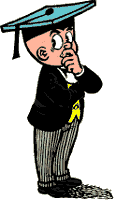Debut
Adhemar made his debut in De Zoon van Nero ("The Son of Nero") (1959), in which he is also born. He surprises his parents and all other people present by being able to talk, smoke a pipe, drink beer and choose his own name. When Nero takes him to the child benefit office he convinces the man behind the counter to raise the money. Later in the story Adhemar wants to leave to see something of the world, but is halted by Petoetje, adoptive son of Meneer and Madam Pheip. He introduces Adhemar to science, which will become his major hobby in the course of the series. Adhemar invents a new petroleum device in the story and strikes oil in their garden, which causes Nero to get rich and convince him that Adhemar's genius ought to be stimulated.
Adhemar had a few predecessors in the series. In the very first Nero album, Het Geheim van Matsuoka ("The Secret of Matsuoka") (1947-1948) Nero is portrayed with a son and daughter on his knee. In later prints they are changed into his nephews. In Het Rattenkasteel ("The Rat Castle") (1948) Nero is seen with another son, this time a baby with a pacifier, but the child is not referred to again in the story, nor the rest of the series. Petoetje, Madam Pheip's adopted son, can also be seen as a prototype of Adhemar. He is very clever and in "De X-Bom" ("The X Bomb") (1955) he is revealed to be a genius inventor and scientist. He reveals that he became intelligent by eating a lot of witlof, while Adhemar gained it by birth. Petoetje was the one who first discovered Adhemar's genius in "De Zoon van Nero" ("The Son of Nero") (1959), when he let him play in his laboratory.
Character
In his first twelve albums Adhemar was dressed as a baby, walking around with a napkin around his neck and carrying a diaper. He acted more like an infant at times, by crying extremely loud when things don't go his way. In "De Kille Man Djaro" ("The Cold Man Djaro") (1962) he also cries because he is scared to cross a crocodile infested lake and in "De Brollebril" ("The Bogus Glasses") (1962) he wets his pants after a parachute jump. From "De Juweleneter" ("The Jewel Eeater") (1963) on he wears a tuxedo and his characteristic baret appears in "Het Groene Vuur" ("The Green Fire") (1966). He loses most of his childlike traits too, despite never aging beyond the age of five. In "De Adhemar Bonbons" ("The Adhemar Pralines") (1989) he reveals that he eats pralines that stop his ageing process.
In some stories Adhemar returns to his childish state of mind, like "Het Zevende Spuitje" ("The Seventh Syringe") (1963) or "De Wallabieten" ("The Wallabytes") (1968), but most of the times he is the most adult of all the characters. He is a sceptic who will doubt all instances of magic, wizardry or fantastic elements and claim, in his trademark catch phrase: "Het is wetenschappelijk niet verantwoord" ("It's scientifically not possible"). In most cases he turns out to be right, but occasionally certain phantasy creatures do turn out to exist after all.
Despite his high I.Q. Adhemar does sometimes makes human errors or turns out to be fallible. His inventions sometimes fail or his laboratory explodes. Some of this failings also lead to new adventures, for instance in "Het Zevende Spuitje" or "Aboe-Markoeb" (1966). In "De Witte Parel" ("The White Pearl") (1962) he is humiliated on television when it turns out he doesn't know any nursery rhymes during a quiz. He decides to go to kindergarten to extinguish this hole in his knowledge.
Many scientists and professors know and admire Adhemar. In "Het Bobobeeldje" ("The Bobo Statue") (1965) we see a signed photograph of Albert Einstein with the message "To my dear friend Adhemar", despite the fact that Einstein died in 1955, four years before Adhemar's birth in the series. Due to Adhemar's genius several people and foreign regimes sometimes abduct him to force him to work for them. [2] Some professors try to murder him out of jealousy.
In "De Blauwe Mannen" ("The Blue Men") (1969) Adhemar turns out to be a fan of Benjamin Britten, Leon Cavallo, Leonard Bernstein, the Festival van Vlaanderen, Ludwig van Beethoven and Wolfgang Amadeus Mozart. In "Nerorock" (1990) he also admits liking pop music, including Jive Bunny & The Mastermixers, The Rolling Stones, Don Henley, Tears For Fears, Leo Fabri, Milli Vanilli, Kylie Minogue, Helmut Lotti and Simple Minds.
Child prodigy
Adhemar's main character trait is his high intelligence. In De Brollebril ("The Bogus Glasses") (1960) his parents send him to a boarding school, but he returns early, claiming he got his degree early. In the same story he gets his own laboratory. From the album "Ottoman de Veertiende" ("Ottoman the Fourteenth") (1974) his lab is located in Kobbegem. In "De Orde van de Wellustige Wezel" ("The Order of the Lustful Weasel") (1984) he also has a lab and rocket platform in the gardens of Nero's new castle in Oostkerke.
Adhemar teaches at several universities, including the University of Oxford, the University of Cambridge and the University of Upsala. [3] He has won the Nobel Prize [4] and speaks 36 languages fluently. In "Het Groene Vuur" ("The Green Fire") (1965) he makes a trip throughout the USA as an advanced fellow of the Belgian American Educational Foundation. He teaches in German philology, trigonometry, nuclear physics, dynamics, [5] chemical equations, [6] typometry, geomontography, aerial photography and geography. [7] In "De Matras van Madras" ("The Mattress of Madras") (1967) we also learn he has three doctor titles in philology, philosophy and nuclear physics and also holds own as doctor honoris causa. Apart from that he is also a biologist, ornithologist and botanist [8] In "Baraka" (1986) he travels to Chernobyl to "extinguish the fire".
Adhemar often puts his intelligence in advantage to the US government. In "De Brollebril" (1960) he sells it for 50.000 dollar. In "De Driedubbelgestreepte" ("The Three Double Striped One") (1962) the Americans want to use him in the space race against Soviet Russia, an act for which he receives a medal in "De Paarse Futen" ("The Purple Great crested grebes" (1967) after he magically sends two American astronauts to the moon with a wand. In "De Juweleneter" ("The Jewel Eater") (1963) Adhemar works for The Pentagon to create a new fuel. The European Defence Agency also hires him in "Hoed je voor Kastar" ("Beware of Kastar") (1973). Adhemar does sometimes work for the Belgian government as well. In "Het Kwade Oog" ("The Evil Eye") (1974-1975) he prepares an anti-inflation file for the Prime Minister.
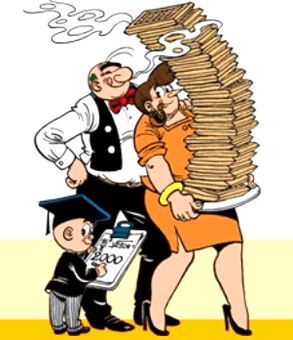
The Adventures of Nero or Nero was a Belgian comic strip drawn by Marc Sleen and the name of its main character. The original title ranged from De Avonturen van Detectief Van Zwam in 1947 to De Avonturen van Nero en zijn Hoed in 1950, and finally De Avonturen van Nero & Co from 1951. It ran in continuous syndication until 2002. From 1947 until 1993 it was all drawn by Sleen himself. From 1992 until 2002 Dirk Stallaert took over the drawing while Sleen kept inventing the stories.

Belgian comics are a distinct subgroup in the comics history, and played a major role in the development of European comics, alongside France with whom they share a long common history. While the comics in the two major language groups and regions of Belgium each have clearly distinct characteristics, they are constantly influencing one another, and meeting each other in Brussels and in the bilingual publication tradition of the major editors. As one of the few arts where Belgium has had an international and enduring impact in the 20th century, comics are known to be "an integral part of Belgian culture".
The Bronzen Adhemar is the official Flemish Community Cultural Prize for Comics, given to a Flemish comics author for his body of work. It is awarded by the Flemish Ministry of Culture during Strip Turnhout, the major Flemish comics festival, once every two years.
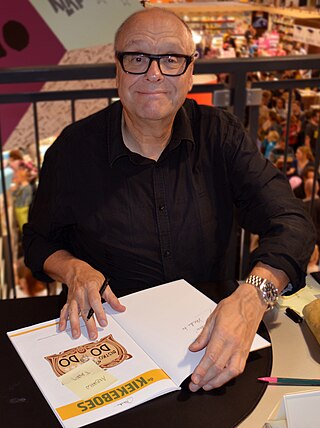
Merho, is a Belgian comic-book writer and artist, best known for creating the comic strip De Kiekeboes.
Gaston Cyriel Durnez was a Flemish columnist, journalist and writer. He worked for the newspaper De Standaard, writing several humorous-satirical columns, and was one of the founders of the Encyclopedie van de Vlaamse Beweging. He was also the writer of De Geschiedenis van Sleenovia (1965), a comic strip by Willy Vandersteen and Edward De Rop, featuring characters from Marc Sleen's The Adventures of Nero, which was subject of a fierce copyright battle between the newspapers De Standaard and Het Volk.

Willy Linthout is a Belgian comics author, best known for the Urbanus comics and his graphic novel Years of the Elephant.
Nero is a Flemish comic book character and the main protagonist in Marc Sleen's long running comic book strip series The Adventures of Nero (1947–2002). He is one of the most recognizable comic book characters in Belgium and comparable to Lambik from the Suske en Wiske series by Willy Vandersteen.
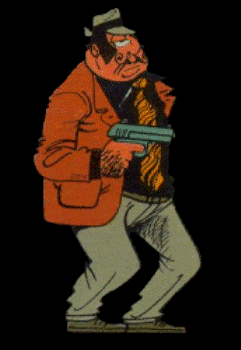
Ricardo is a Flemish comic book character and the main antagonist in The Adventures of Nero series by Marc Sleen. He is a ruthless maffiosi who hates Nero with a passion. Together with Geeraard de Duivel and Matsuoka Ricardo is Nero's most frequent opponent, appearing in at least 24 albums, even surviving several seemingly deaths.

Abraham Tuizentfloot, in full Oscar Abraham Tuizentfloot, is a Flemish comic book character from the Belgian comic book series The Adventures of Nero by Marc Sleen. He is a crazy little man who dresses up as a pirate and has a tendency to attack people. In the series he is one of Nero's personal friends.

Piet Fluwijn en Bolleke was a Belgian gag-a-day comic strip series drawn by Marc Sleen from 1944 until 1965. It was continued by artists Hurey and Jean-Pol until 1974.

De Lustige Kapoentjes was a long-running Flemish comic book series, which existed under different titles and was drawn by different artists, among whom Marc Sleen and Willy Vandersteen are the most well known. The series was published in 't Kapoentje, the youth supplement of Het Volk, and in Ons Volkske, the youth supplement of De Standaard. They were the mascots of 't Kapoentje from 1947 until the magazine's demise in 1985.

De Ronde van Frankrijk was a Belgian gag cartoon comic strip series by Marc Sleen, in which he made a comedic report of every daily tournament of the annual cycling contest the Tour de France. Sleen drew the strip each year, from 1947 up until 1964, for the Flemish newspapers Het Vrije Volksblad and Het Volk.
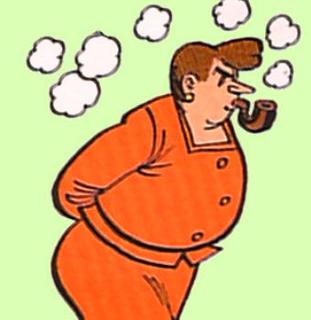
Madam Pheip is a character from the Flemish comic strip The Adventures of Nero by Marc Sleen. In the series she is one of Nero 's personal friends and married to Meneer Pheip, with whom she has one child, Clo-Clo. Madam Pheip also adopted two children, Petoetje, and Petatje.
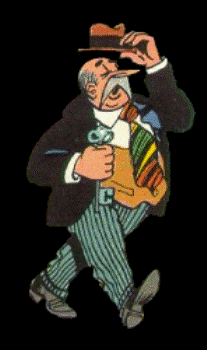
Meneer Pheip is a Flemish comic book character from the Belgian comic strip The Adventures of Nero by Marc Sleen. In the series he is part of Nero's personal circle of friends, despite often being up in arms with him. He is the husband of Madam Pheip, father of Clo-Clo and adoptive father of Petoetje and Petatje.
Detective Van Zwam is a Flemish comics character in the Belgian comics series The Adventures of Nero by Marc Sleen. He is a brilliant detective and able to find clues from even the tiniest of evidence.
Wij, Heren van Zichem was a Flemish TV drama series, originally broadcast between 1969 and 1972 in 26 episodes on the BRT. The program was based on several novels by Ernest Claes, who died just a few months before the show first aired. All episodes were shot in the Flemish village Zichem. At the time it was one of the most popular TV series in Flanders, attracting almost 2,960,000 viewers which is about 3/4 of all Flemish people. Tourism to the village boomed, while it hardly had enough bars, let alone restaurants to accommodate the tourists. In a 2004 interview with Het Nieuwsblad actor Fons Exelmans remembered that tourists were often confused because certain houses and buildings were located less close to each other than in the series. The actors were also invited to appear during annual festivities as promotional stunts.
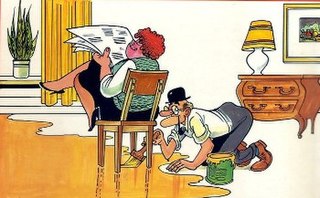
Oktaaf Keunink was a Belgian comics series, written and drawn by Marc Sleen. It was published between 16 November 1952 and 4 April 1965 in the magazine Ons Zondagsblad.

Petoetje is a Belgian comics character from the comic strip The Adventures of Nero by Marc Sleen. He is a teenage black boy who originates from Papua New Guinea, but was adopted by Madam Pheip and Meneer Pheip, along with another orphan child, Petatje.

Petatje is a Belgian comics character from the comic strip The Adventures of Nero by Marc Sleen. She is a teenage girl who was adopted by Madam Pheip and Meneer Pheip, along with another orphan child, Petoetje.

Years of the Elephant is a Flemish graphic novel by Willy Linthout. Linthout was awarded the 2009 Bronzen Adhemar for this work.
